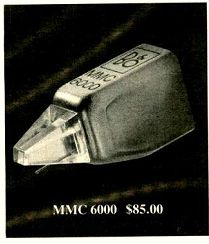
Bang & Olufsen has developed an extraordinary new CD-4 cartridge.
$85.00
Before you listen to it there are a few things we think you should know.
It is an integrated system. The MMC 6000 cartridge leaves the factory as a sealed unit, a non-replaceable stylus assembly integrated with the coils, magnet, and output terminals. This significant departure from traditional "two piece" cartridge construction allowed Bang & Olufsen engineers to meet performance standards previously unattainable, but definitely required for optimum CD-4 high frequency reproduction. Most important, this integration of the stylus assembly let Bang & Olufsen engineers greatly reduce the effective tip mass (ETM), the size and mass of the cantilever, Moving Micro Cross (Bang & Olufsen's patented device for superb stereo separation), and transducing elements of the MMC 6000. In other words then, the manufacture of the MMC 6000 as an integrated unit represents an absolute, no-compromise approach to cartridge design.
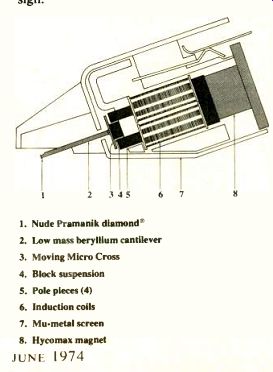
1. Nude Pramanik diamond
2. Low mass beryllium cantilever
3. Moving Micro Cross
4. Block suspension
5. Pole pieces (4)
6. Induction coils
7. Mu-metal screen
8. Hycomax magnet
The effective tip mass is .22mg. Extensive testing has shown that the effective tip mass (ETM) of a cartridge is the factor most directly related to record and stylus wear. It has also been demonstrated that record wear due to high ETM is most severe in the high frequencies; obviously then, a high ETM is a substantial problem with CD-4 high frequency modulations.
The integrated manufacturing method used to produce the MMC 6000 contributes to the extremely low ETM of .22mg. and a tip resonance point of over 50,000 Hz.
It tracks at 1 gram. The MMC 6000's low vertical tracking force (VTF), greatly reduced ETM, and compliance rating of 30 x 10^-6, create an optimum relationship between those factors of a cartridge which have the greatest effect on performance.
VTF, effective tip mass, and compliance should never be evaluated singly; the most critical task within cartridge design is establishing their ideal interrelationship.
Therefore you should consider the 1 gram tracking force of the MMC 6000 as just one result of a superior cartridge design.
While VTF is often a reliable parameter of overall quality, its relationship to record wear is secondary when compared to the ETM. It should be understood that at high frequency modulation the forces applied to the groove walls are several hundred times as great as the VTF. And to a large extent then, these forces determine record wear and are directly related to effective tip mass.
It features a Pramanik stylus. The MMC 6000 utilizes a multi-radial diamond developed by cartridge engineer, S. K. Pramanik of Bang & Olufsen. The unique shape of the diamond was developed to obtain maximum contact with the groove walls along its vertical axis and minimum contact along its horizontal axis. The increased contact along the vertical axis reduces record and stylus wear by significantly lowering the amount of force applied per unit of surface. The minimum contact along the horizontal axis guarantees the extremely accurate tracing of the CD-4 high frequency modulations between 20,000 and 45,000 Hz. As opposed to normal diamond styli, only the very tip of the Pramanik diamond is mounted on the cantilever. This procedure and the beryllium cantilever, stiffer and lighter than commonly used aluminum, further reduces the ETM of the MMC 6000.
--------
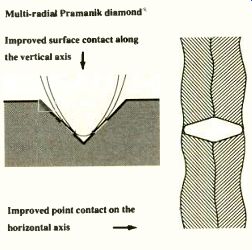
---Multi-radial Pramanik diamond; Improved surface contact along the
vertical axis; Improved point contact on the horizontal axis
----------------
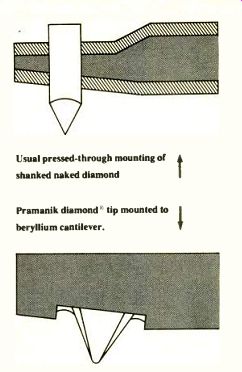
------ Usual pressed-through mounting of shanked naked diamond
------ Pramanik diamond tip mounted to beryllium cantilever.
It meets the Class A criteria.
The RCA/JVC rating system for CD-4 cartridges
Every MMC 6000 has a Class A rating.
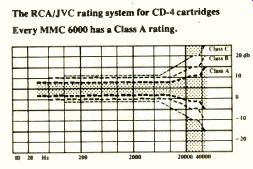
Discrete 4-channel sound became a reality through the work of the RCA/JVC joint development team. Accordingly, RCA/ JVC engineers established criteria by which the performance and 4-channel capabilities of cartridges could be evaluated.
Their rating system includes four classes:
A, B, C, and D, class A being the highest and class D considered as unacceptable.
The class A rating is given to only those cartridges with a frequency response varying no more than ± 10dB between 20,000 and 40,000 Hz, with channel separation better than 14dB at 30,000 Hz, and more than 1m V output. Every MMC 6000 cartridge meets or exceeds these specifications. As proof of each unit's level of performance, the MMC 6000 comes with its own calibration card and frequency response curve. The calibration card states the output voltage, channel separation, and the balance between channels. The frequency response curve is produced for each channel on a Bruel and Kjaer level recorder and shows the performance levels from 20 to 45,000 Hz.
Bang & Olufsen Bang & Olufsen of America
2271 Devon Ave.
Elk Grove Village, Ill. 60007 USA
Also see:
Leslie Speakers (ad)
BIC Venturi (ad)